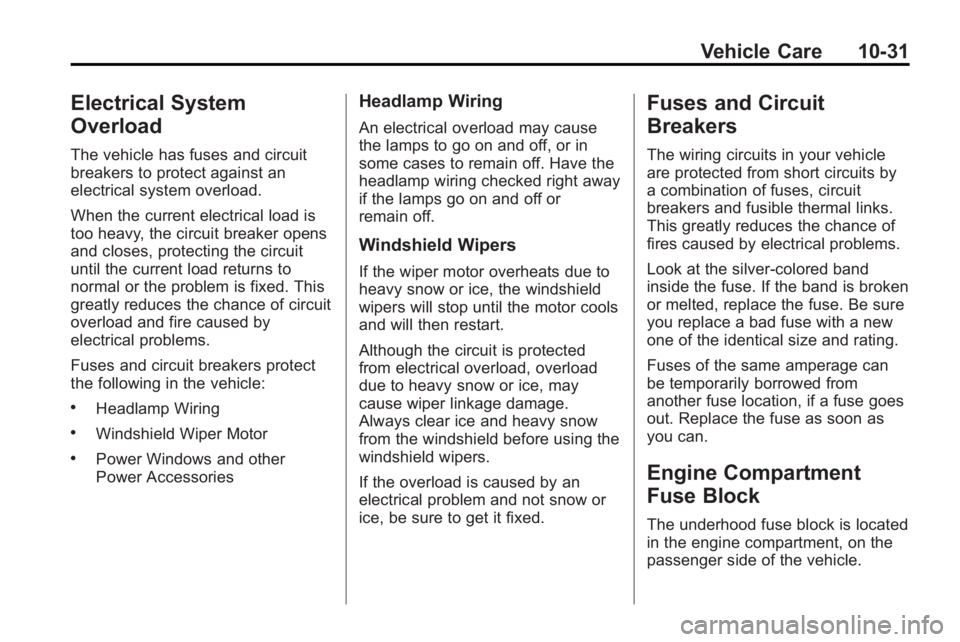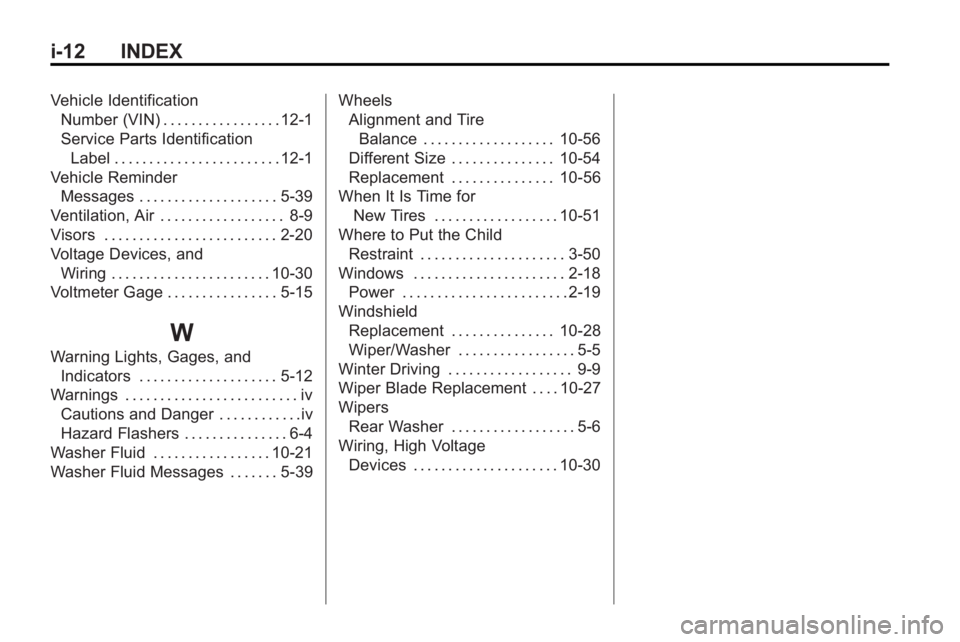wiper size BUICK ENCLAVE 2010 Owner's Manual
[x] Cancel search | Manufacturer: BUICK, Model Year: 2010, Model line: ENCLAVE, Model: BUICK ENCLAVE 2010Pages: 438, PDF Size: 2.47 MB
Page 325 of 438

Vehicle Care 10-27
Park on a fairly steep hill, with the
vehicle facing downhill. Keeping
your foot on the regular brake, set
the parking brake.
.To check the parking brake's
holding ability: With the engine
running and the transmission in
N (Neutral), slowly remove foot
pressure from the regular brake
pedal. Do this until the vehicle is
held by the parking brake only.
.To check the P (Park)
mechanism's holding ability:
With the engine running, shift to
P (Park). Then release the
parking brake followed by the
regular brake.
Contact your dealer/retailer if
service is required.
Wiper Blade Replacement
Windshield wiper blades should be
inspected for wear or cracking. See
Scheduled Maintenance
on
page 11‑2for more information. Replacement blades come in
different types and are removed in
different ways. To replace the wiper
blade assembly:
1. Pull the windshield wiper arm
away from the windshield.
2. Press the button in the middle ofthe wiper arm connector and pull
the wiper blade away from the
arm connector.
3. Install the new wiper blade and make sure the wiper blade locks
into place. For the proper size and type see
Maintenance Replacement Parts
on
page 11‑8.
Backglass Wiper Blade
To replace the backglass wiper
blade:
1. Pull the wiper blade assembly away from the backglass.
The backglass wiper blade will
not lock in a vertical position so
care should be used when
pulling it away from the vehicle.
2. Rotate the wiper blade assembly, hold the wiper arm in
position, and push the blade
away from the wiper arm.
3. Replace the wiper blade.
4. Return the wiper arm and blade assembly to the rest position on
the glass.
Page 329 of 438

Vehicle Care 10-31
Electrical System
Overload
The vehicle has fuses and circuit
breakers to protect against an
electrical system overload.
When the current electrical load is
too heavy, the circuit breaker opens
and closes, protecting the circuit
until the current load returns to
normal or the problem is fixed. This
greatly reduces the chance of circuit
overload and fire caused by
electrical problems.
Fuses and circuit breakers protect
the following in the vehicle:
.Headlamp Wiring
.Windshield Wiper Motor
.Power Windows and other
Power Accessories
Headlamp Wiring
An electrical overload may cause
the lamps to go on and off, or in
some cases to remain off. Have the
headlamp wiring checked right away
if the lamps go on and off or
remain off.
Windshield Wipers
If the wiper motor overheats due to
heavy snow or ice, the windshield
wipers will stop until the motor cools
and will then restart.
Although the circuit is protected
from electrical overload, overload
due to heavy snow or ice, may
cause wiper linkage damage.
Always clear ice and heavy snow
from the windshield before using the
windshield wipers.
If the overload is caused by an
electrical problem and not snow or
ice, be sure to get it fixed.
Fuses and Circuit
Breakers
The wiring circuits in your vehicle
are protected from short circuits by
a combination of fuses, circuit
breakers and fusible thermal links.
This greatly reduces the chance of
fires caused by electrical problems.
Look at the silver-colored band
inside the fuse. If the band is broken
or melted, replace the fuse. Be sure
you replace a bad fuse with a new
one of the identical size and rating.
Fuses of the same amperage can
be temporarily borrowed from
another fuse location, if a fuse goes
out. Replace the fuse as soon as
you can.
Engine Compartment
Fuse Block
The underhood fuse block is located
in the engine compartment, on the
passenger side of the vehicle.
Page 438 of 438

i-12 INDEX
Vehicle IdentificationNumber (VIN) . . . . . . . . . . . . . . . . . 12-1
Service Parts Identification
Label . . . . . . . . . . . . . . . . . . . . . . . . 12-1
Vehicle Reminder Messages . . . . . . . . . . . . . . . . . . . . 5-39
Ventilation, Air . . . . . . . . . . . . . . . . . . 8-9
Visors . . . . . . . . . . . . . . . . . . . . . . . . . 2-20
Voltage Devices, and
Wiring . . . . . . . . . . . . . . . . . . . . . . . 10-30
Voltmeter Gage . . . . . . . . . . . . . . . . 5-15
W
Warning Lights, Gages, and
Indicators . . . . . . . . . . . . . . . . . . . . 5-12
Warnings . . . . . . . . . . . . . . . . . . . . . . . . . iv Cautions and Danger . . . . . . . . . . . .iv
Hazard Flashers . . . . . . . . . . . . . . . 6-4
Washer Fluid . . . . . . . . . . . . . . . . . 10-21
Washer Fluid Messages . . . . . . . 5-39 Wheels
Alignment and Tire
Balance . . . . . . . . . . . . . . . . . . . 10-56
Different Size . . . . . . . . . . . . . . . 10-54
Replacement . . . . . . . . . . . . . . . 10-56
When It Is Time for New Tires . . . . . . . . . . . . . . . . . . 10-51
Where to Put the Child Restraint . . . . . . . . . . . . . . . . . . . . . 3-50
Windows . . . . . . . . . . . . . . . . . . . . . . 2-18 Power . . . . . . . . . . . . . . . . . . . . . . . . 2-19
Windshield Replacement . . . . . . . . . . . . . . . 10-28
Wiper/Washer . . . . . . . . . . . . . . . . . 5-5
Winter Driving . . . . . . . . . . . . . . . . . . 9-9
Wiper Blade Replacement . . . . 10-27
Wipers Rear Washer . . . . . . . . . . . . . . . . . . 5-6
Wiring, High Voltage Devices . . . . . . . . . . . . . . . . . . . . . 10-30